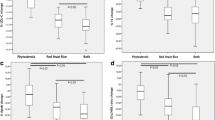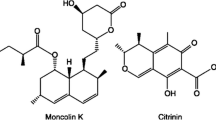Abstract
Objective
To observe the effect of combining red yeast rice and Lactobacillus casei (L. casei) in lowering cholesterol in patients with primary hyperlipidemia, the later has also been shown to remove cholesterol in in vitro studies.
Methods
A double-blind clinical trial was conducted to evaluate the cholesterol-lowering effect of the combination of red yeast rice and L. casei. Sixty patients with primary hyperlipidemia were recruited and randomized equally to either the treatment group (red yeast rice + L. casei) or the control group (red yeast rice + placebo). One red yeast rice capsule and two L. casei capsules were taken twice a day. The treatment lasted for 8 weeks, with an extended follow-up period of 4 weeks. The primary endpoint was a difference of serum low-density lipoprotein cholesterol (LDL-C) level at week 8.
Results
At week 8, the LDL-C serum level in both groups was lower than that at baseline, with a decrease of 33.85±26.66 mg/dL in the treatment group and 38.11±30.90 mg/dL in the control group; however, there was no statistical difference between the two groups (P>0.05). The total cholesterol was also lower than the baseline in both groups, yet without a statistical difference between the two groups. The only statistically signifificant difference between the two groups was the average diastolic pressure at week 12, which dropped by 2.67 mm Hg in the treatment group and increased by 4.43 mm Hg in the placebo group (P<0.05). The antihypertensive activity may be associated with L. casei. Red yeast rice can signifificantly reduce LDL-C, total cholesterol and triglyceride.
Conclusion
The combination of red yeast rice and L. casei did not have an additional effect on lipid profifiles.
Similar content being viewed by others
References
Berliner JA, Navab M, Fogelman AM, Frank JS, Demer LL, Edwards PA, et al. Atherosclerosis: basic mechanisms. Oxidation, inflammation, and genetics. Circulation 1995;91:2488–2496.
Gould AL, Davies GM, Alemao E, Yin DD, Cook JR. Cholesterol reduction yields clinical benefits: meta-analysis including recent trials. Clin Ther 2007;29:778–794.
Moghadasian MH, McManus BM, Godin DV, Rodrigues B, Frohlich JJ. Proatherogenic and antiatherogenic effects of probucol and phytosterols in apolipoprotein E-deficient mice: possible mechanisms of action. Circulation 1999;99:1733–1739.
Scandinavian Simvastatin Survival Study Group. Randomised trial of cholesterol lowering in 4444 patients with coronary heart disease: the Scandinavian Simvastatin Survival Study (4S). Lancet 1994;344:1383-1389.
Garcia-Calvo M, Lisnock J, Bull HG, Hawes BE, Burnett DA, Braun MP, et al. The target of ezetimibe is niemannpick C1-like 1 (NPC1L1). Proc Natl Acad Sci U S A 2005;102:8132–8137.
Sharp Collaborative Group. Study of Heart and Renal Protection (SHARP): randomized trial to assess the effects of lowering low-density lipoprotein cholesterol among 9,438 patients with chronic kidney disease. Am Heart J 2010;160:785-794.
Gagne C, Bays HE, Weiss SR, Mata P, Quinto K, Melino M, et al. Efficacy and safety of ezetimibe added to ongoing statin therapy for treatment of patients with primary hypercholesterolemia. Am J Cardiol 2002;90:1084–1091.
Eisenberg DM, Davis RB, Ettner SL, Appel S, Wilkey S, Van Rompay M, et al. Trends in alternative medicine use in the United States, 1990–1997: results of a follow-up national survey. JAMA 1998;280:1569–1575.
He RR, Chen L, Lin BH, Matsui Y, Yao XS, Kurihara H. Beneficial effects of oolong tea consumption on dietinduced overweight and obese subjects. Chin J Integr Med 2009;15:34–41.
Smith DJ, Olive KE. Chinese red rice-induced myopathy. South Med J 2003;96:1265–1267.
Liu J, Zhang J, Shi Y, Grimsgaard S, Alraek T, Fonnebo V. Chinese red yeast rice (Monascus purpureus) for primary hyperlipidemia: a meta-analysis of randomized controlled trials. Chin Med 2006;1(4):1–13.
Su YC, Wang JJ, Lin TT, Pan TM. Production of the secondary metabolites gamma-aminobutyric acid and monacolin K by Monascus. J Ind Microbiol Biotechnol 2003;30:41–46.
Sudha M, Chauhan P, Dixit K, Babu S, Jamil K. Probiotics as complementary therapy for hypercholesterolemia. Biology Med 2009;1:4.
Oyetayo V, Adetuyi F, Akinyosoye F. Safety and protective effect of Lactobacillus acidophilus and Lactobacillus casei used as probiotic agent in vivo. Afr J Biotechnol 2003;2:448–452.
Machorro-Méndez IA, Hernández-Mendoza A, Cardenia V, Rodriguez-Estrada MT, Lercker G, Spinelli F, et al. Assessment of in vitro removal of cholesterol oxidation products by Lactobacillus casei ATCC334. Lett Appl Microbiol 2013;57:443–450.
Brashears MM, Gilliland SE, Buck LM. Bile salt deconjugation and cholesterol removal from media by Lactobacillus casei. J Dairy Sci 1998;81:2103–2110.
Chiu CH, Lu TY, Tseng YY, Pan TM. The effects of Lactobacillus-fermented milk on lipid metabolism in hamsters fed on high-cholesterol diet. Appl Microbiol Biotechnol 2006;71:238–245.
Park YH, Kim JG, Shin YW, Kim HS, Kim YJ, Chun T, et al. Effects of Lactobacillus acidophilus 43121 and a mixture of Lactobacillus casei and Bifidobacterium longum on the serum cholesterol level and fecal sterol excretion in hypercholesterolemia-induced pigs. Biosci Biotechnol Biochem 2008;72:595–600.
Kobashi K, Nishizawa I, Yamada T, Hase J. A new hydrolase specific for taurine-conjugates of bile acids. J Biochem 1978;84:495–497.
Huang CF, Li TC, Lin CC, Liu CS, Shih HC, Lai MM. Efficacy of Monascus purpureus Went rice on lowering lipid ratios in hypercholesterolemic patients. Eur J Cardiovasc Prev Rehabil 2007;14:438–440.
Liong MT, Shah NP. Optimization of cholesterol removal by probiotics in the presence of prebiotics by using a response surface method. Appl Environ Microbiol 2005;71:1745–1753.
Liong MT, Shah NP. Effects of a Lactobacillus casei synbiotic on serum lipoprotein, intestinal microflora, and organic acids in rats. J Dairy Sci 2006;89:1390–1399.
Sutton A. Product development of probiotics as biological drugs. Clin Infect Dis 2008;46 (Suppl 2):S128-S132; discussion S144–S151.
Ooi LG, Liong MT. Cholesterol-lowering effects of probiotics and prebiotics: a review of in vivo and in vitro findings. Int J Mol Sci 2010;11:2499–2522.
Sawada H, Furushiro M, Hirai K, Motoike M, Watanabe T, Yokokura T. Purification and characterization of an antihypertensive compound from Lactobacillus casei. Agric Biol Chem 1990;54:3211–3219.
Sanders ME. Considerations for use of probiotic bacteria to modulate human health. J Nutr 2000;130(2S Suppl):384S–390S.
Bays H. Statin safety: an overview and assessment of the data—2005. Am J Cardiol 2006;97(8A):6C–26C.
Illingworth DR, Tobert JA. A review of clinical trials comparing HMG-CoA reductase inhibitors. Clin Ther 1994;16:366–385; discussion365.
Vandenberg BF, Robinson J. Management of the patient with statin intolerance. Curr Atheroscler Rep 2010;12:48–57.
Deruiter J, Jacyno JM, Davis RA, Cutler HG. Studies on aldose reductase inhibitors from fungi. ?. Citrinin and related benzopyran derivatives. J Enzyme Inhib 1992;6:201–210.
Blanc PJ, Laussac JP, Le Bars J, Le Bars P, Loret MO, Pareilleux A, et al. Characterization of monascidin A from Monascus as citrinin. Int J Food Microbiol 1995;27:201–213.
Heber D, Lembertas A, Lu QY, Bowerman S, Go VL. An analysis of nine proprietary Chinese red yeast rice dietary supplements: implications of variability in chemical profile and contents. J Altern Complement Med 2001;7:133–139.
Chen F, Hu X. Study on red fermented rice with high concentration of monacolin K and low concentration of citrinin. Int J Food Microbiol 2005;103:331–337.
Author information
Authors and Affiliations
Corresponding author
Additional information
Supported by the Committee on Chinese Medicine and Pharmacy, Department of Health, Taiwan, China (Protocol No.: CCMP97-RD-043) and Chung Shan Medical University (Protocol No.: CSMU-INT-104-03)
Rights and permissions
About this article
Cite this article
Lee, CY., Yu, MC., Perng, WT. et al. No additional cholesterol-lowering effect observed in the combined treatment of red yeast rice and Lactobacillus casei in hyperlipidemic patients: A double-blind randomized controlled clinical trial. Chin. J. Integr. Med. 23, 581–588 (2017). https://doi.org/10.1007/s11655-016-2530-1
Received:
Published:
Issue Date:
DOI: https://doi.org/10.1007/s11655-016-2530-1




